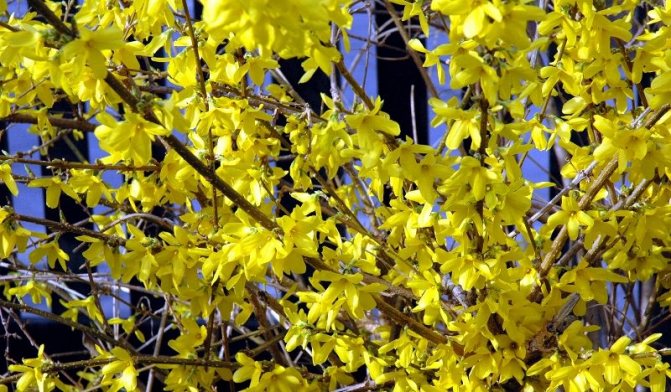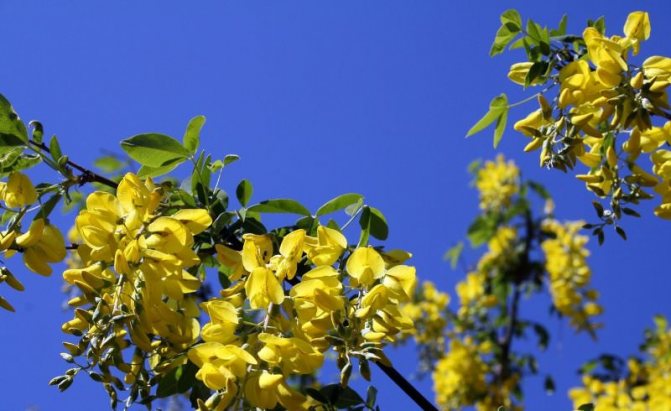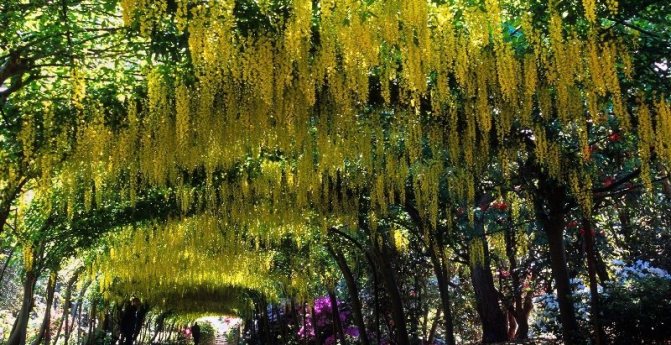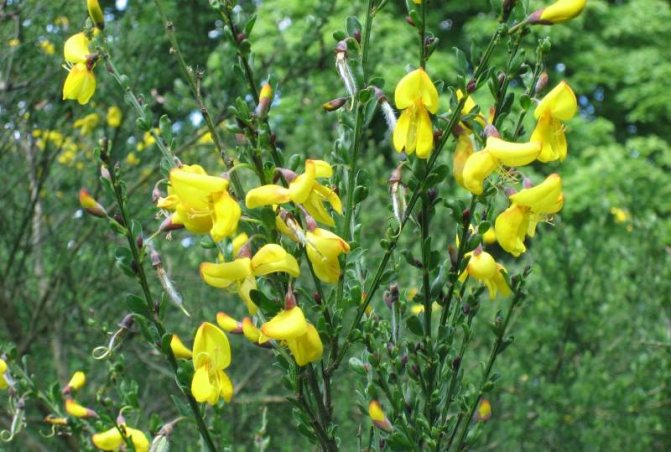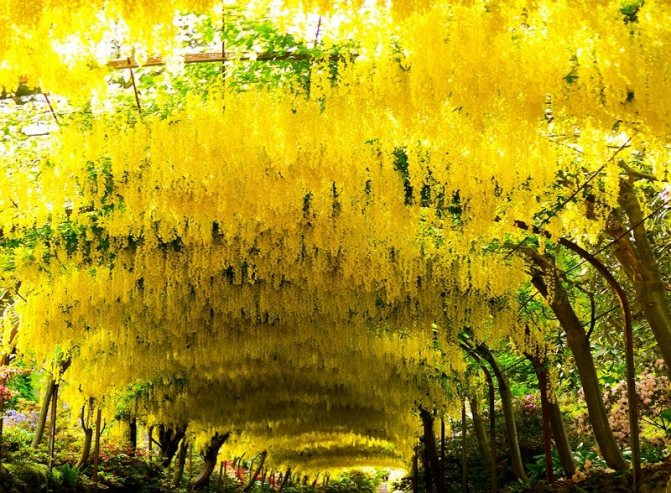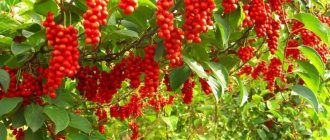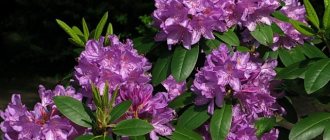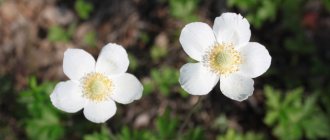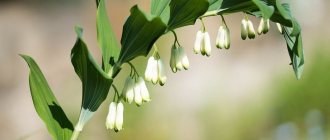Home »Landscaping» Lianas, Bushes and Trees
Lianas, Bushes and Trees
Vladimir Serchenko
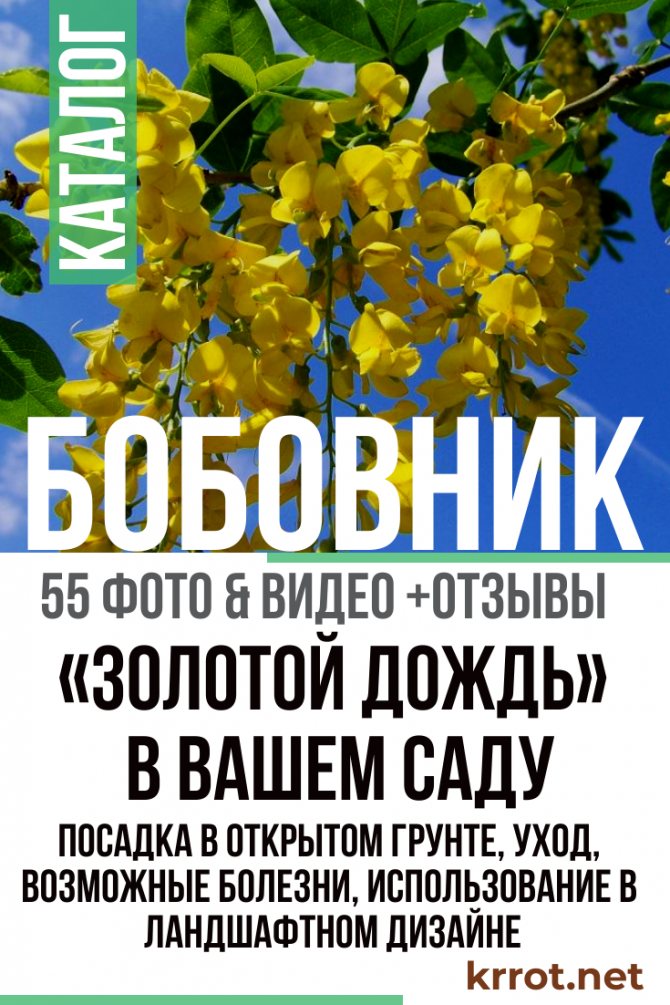
In May - June, a very ornamental plant with beautiful foliage blooms, which is called bean. This shrub is not as widespread in our gardens and parks as lilacs, viburnum or spirea, but it certainly deserves much more attention. We will tell you about planting a legume and caring for this incredibly ornamental plant in our article.
- Description
- Precautions
- Types and forms of bean
- Features of vegetation
- Reproduction
- Landing site
- Planting a bean
- Growing conditions
- Care
- Pruning and shaping the crown
- Winter care
- Diseases and pests
- Use in landscape design and economic purposes
- PHOTO GALLERY
Description of the bean
Representatives of the genus grow up to 3-7 m, depending on the species and variety. The spreading crown of weeping or straight flexible shoots can reach a width of 3-4 meters. The leaves are trifoliate, ovate on a long petiole appear before flowering. The underside of the leaf plate and shoots are slightly pubescent.
The flowering of the legume lasts from late April to June. Small bright yellow flowers resemble small butterflies in shape. They are collected in numerous racemose inflorescences, the length of which can reach from 20 to 50 cm.
Fruits in dry narrow pods 5-6 cm long ripen in September. Unfortunately, the flowering of leguminous plants in cold regions is not frequent and not so abundant.
Bobovnik: photo
Types and varieties
Anagyrolist or common bean (Laburnum anagyroides synonym for L. vulgare) native to the Mediterranean, Eastern France and Central Europe. The most widely cultivated representative of the genus, which is a tall shrub with straight shoots or a tree with a short trunk up to 5-6 m in height.
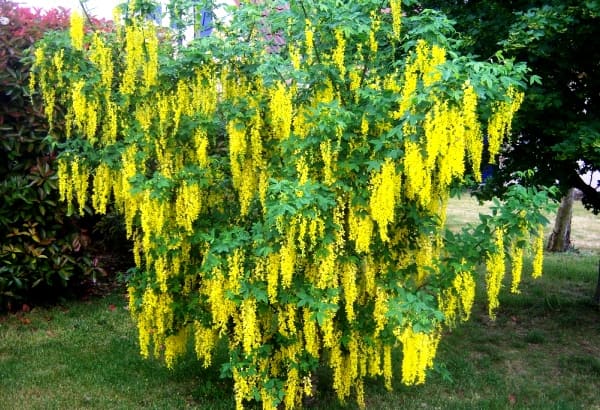

The leaves are pubescent, dark green, resembling the shape of a clover. It blooms at the turn of May and June. Its golden-yellow odorless flowers are collected in inflorescences about 15-25 cm long. It reproduces well by self-sowing, young seedlings are distinguished by rapid growth.
"Aureum" - in spring the leaves of this variety have an intense golden yellow color, which eventually turn greenish-yellow.
"Pendulum" - is distinguished by very decorative, long, drooping shoots.
Alpine bean (L. alpinum)... Its hanging, fragrant inflorescences reach a length of 30-40 cm. Leaves and stems are not pubescent. This species blooms about two weeks later than the common bean.
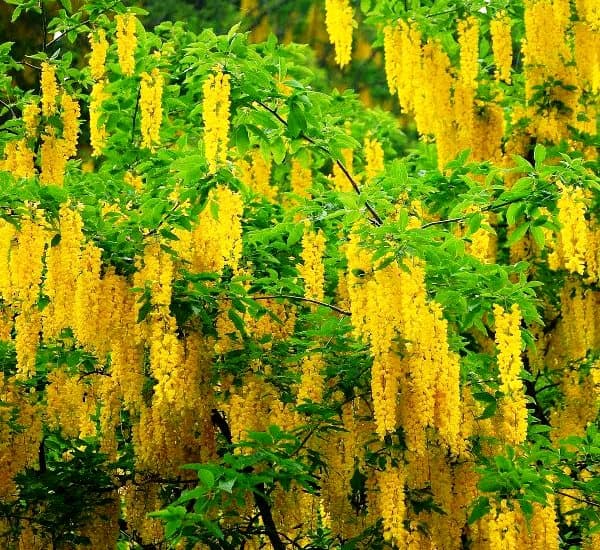

"Pendula" is a tree on a trunk with decorative long sparse shoots that hang down almost to the ground.
Sunspire is a dwarf group that you don't often see on sale.
Bobovnik Vaterera (Laburnum x watereri) - is an interspecific hybrid. It has the shape of a low, multi-stemmed tree with drooping upper shoots. The tree reaches its maximum size only after 20-50 years.
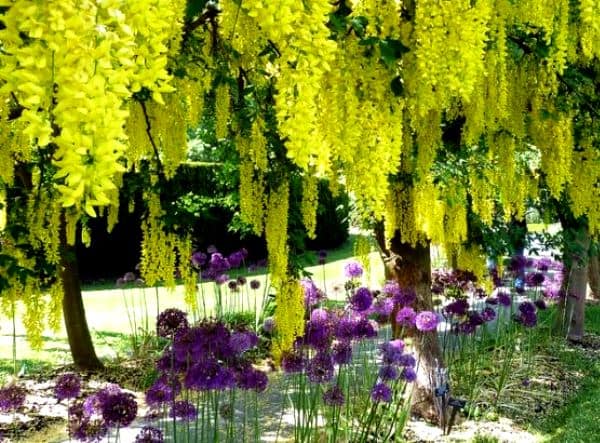

Fragrant flowers are collected in very dense and long inflorescences 40 cm in length. Vossii is characterized by the most impressive and numerous 50 cm long inflorescences. This species is sensitive to severe frosts and therefore needs shelter.
In nurseries you can also find pink bean or Laburnocytisus adamii, which is an intergeneric hybrid with broom.
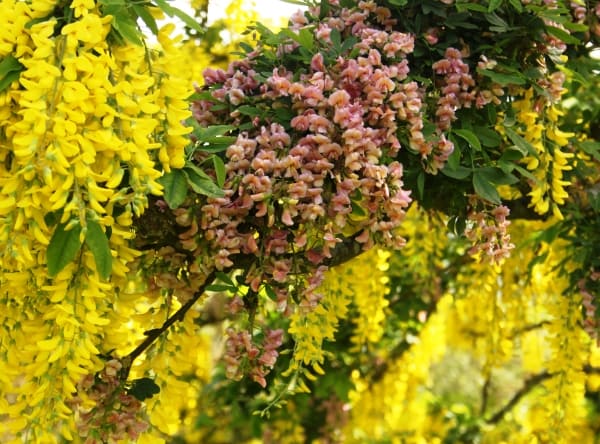

Both yellow and pink inflorescences bloom on the tree at the same time, which can acquire a red and purple hue.
From seed
Growing legumes from seeds is not difficult. To do this, it is better to choose large ripe seeds that have ripened on large, abundantly flowering plants. Seed ripening occurs in September.
Leguminous plants reproduce in several ways:
- seeds;
- cuttings;
- layering;
- dividing the bush.
Timing
You can sow Golden Rain in the fall by planting it in a container with garden soil not very deep (1-2 cm). Seedlings appear in 2-3 weeks. When the seedlings grow up (after 2 months), they must be planted in separate containers. It is necessary to plant bean seedlings in open ground in the spring (as soon as the snow melts). It is necessary to protect young plants from wind and cold.
Did you know?
According to Feng Shui, broom is considered a symbol of prosperity. It activates energy, maintains good spirits and optimism.
Preparation
In order for the seeds to germinate better, they are damaged. This process is called. You can process the seeds with sandpaper, a nail file. Another preparation method is to pour boiling water or acid over the seeds. If the membrane is damaged, the growth of the sprout occurs faster. Seeds will sprout earlier if kept in the refrigerator for 1 month before sowing.
Sowing and follow-up care
In spring, golden rain is sown after the snow melts. After planting seeds in the ground to a depth of 1 cm, cover with cellophane.
For good growth, it is necessary to weed the seedlings, while being careful - all parts of the plant are poisonous. not required as legume is drought tolerant. It is useful for development. Plants grown from seeds bloom in 3-5 years.
Did you know?
The alkaloid cytisine, which is found in broom seeds, is used in the manufacture of drugs
«
Tabex
»,
intended for smoking cessation.
Landing
In the spring, before planting, it is advisable to treat seedlings with growth stimulants. It is better to plant shoots in groups in a place protected from the wind, this contributes to abundant flowering. Before planting, it is necessary to clean it from, add it to the prepared soil, etc. Young shoots must be covered for the winter. In the first 2-3 years, the shoots of Golden Rain are very vulnerable to low temperatures.
Planting a bean
Choose a place for planting that is warm and sunny, protected from strong winds, since young bean seedlings can freeze under strong winds in winter, and flowering is not so abundant in the shade. The ornamental bean shrub prefers fertile, permeable, moderately moist soil with an alkaline pH, although it adapts well to poor sandy and acidic soil.
Plants have a very extensive root system that does not allow transplanting. Therefore, it is necessary to very carefully choose the place of planting bean.
Seedlings with a closed root system are planted from spring to autumn, and with an open one - in early spring or mid-autumn. In clay soils at the bottom of the pit, it is necessary to lay out a drainage layer of broken brick or large expanded clay, and add sand to the soil itself.
The root ball is lowered into the pit and sprinkled with earth, which is pre-mixed with compost. The land is well tamped and watered. To avoid drying out and weed growth, the land around the plant is mulched with compost or bark. Plants on a trunk and single-stemmed trees are tied to a support for the first time.
Landing site
In order for the bean to develop quickly and delight with lush flowering, you need to choose a suitable place for planting it. The plot in the garden where the shrub is planted is more than 50% a guarantee of lush flowering, for which this ornamental plant is valued.
For planting shrubs, a sunny place in an open area, protected from wind and drafts, is best suited.


Bobovnik loves sunny places without strong winds and drafts.
Semi-shaded areas on the south side of buildings are also suitable for bean trees. It is the lack of lighting that negatively affects the flowering of the plant. In the shade, the legume will develop slowly, give little growth and bloom poorly. In shady places with low light, the plant may even shed its foliage.
back to menu ↑
See also: How to make and decorate beautiful garden beds with your own hands: simple, tall, smart. For flowers and vegetables. Original Ideas (80+ Photos & Videos)
Bean Berry Care - Golden Rain
The shrub tolerates drought well, but young seedlings need to be watered once a week and even more often in dry summers. Watering of adult large plants is carried out only in the absence of rain for a long time.
Despite the resistance to frost, young 2-3-year-old plants can freeze slightly, especially in severe frosts. It is recommended to insulate the Vaterer hybrid with agrofibre. Due to the sloping shape, snow accumulates on the branches of the shrub, which must be shaken off so that it does not break the shoots.
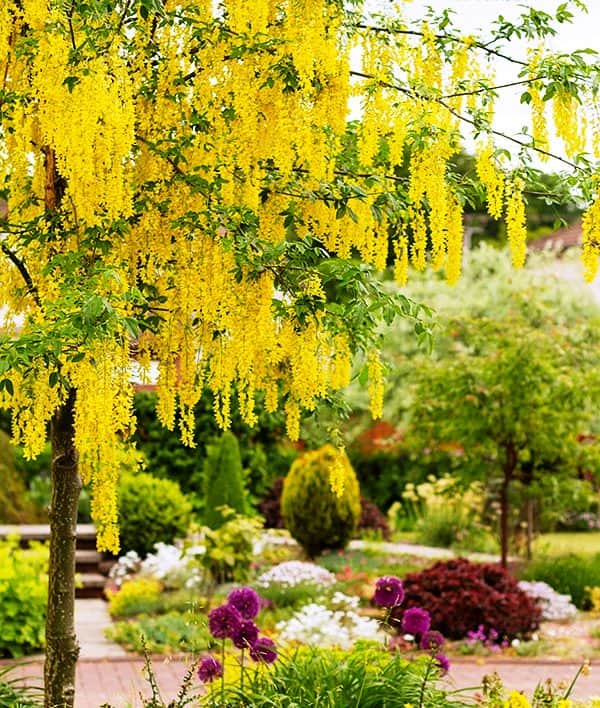

The ornamental bean shrub does not tolerate pruning, after which it weakens and slowly recovers. However, if it is necessary to remove damaged or dry branches, then this should be done in early spring. If there is a need to shorten a living branch, then be sure to close the cut with garden pitch, which will protect the plant from infections.
The legume care includes spring feeding with compost, which is dug up with the ground around the bush. So that the ripening of numerous fruits does not weaken the culture, it is better to remove them immediately.
Landing
Broom planting is carried out in the spring before the active development of the plant begins, that is, at the end of March or at the beginning of April, provided that the soil is no longer frozen and the snow has completely melted.
Sapling selection
At the time of purchase, you should choose a seedling that meets the following requirements:
- young and short specimen, preferably up to 1 m in height;
- basal neck in thickness - at least 3 cm in diameter;
- the root system is not exposed, it is better - in a tub or earthen coma;
- the buds have not yet begun to bloom.
Overgrown specimens in the active growth phase are very difficult to take root and get sick for a long time after transplantation.
When buying a seedling, you should ask the country of origin. Italy and Holland produce material that is intended for cultivation exclusively in the southern regions, and for the middle lane it is better to pick up specimens from Germany.
A place
The main parameters that you should pay attention to when choosing a site for planting are the level of illumination and protection from winds.
For normal growth and flowering, the shrub needs a sufficient amount of direct sunlight. If it is in the shade for at least half the day, it can delay the onset of flowering or cause shedding of foliage. The south side next to the wall of the house or fence is ideal.
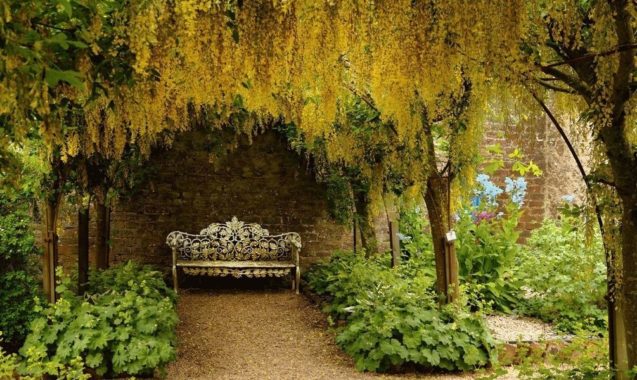

Wind in the area is extremely undesirable, as it can impair all the decorative properties of the plant. To reduce the effect of the wind, brooms are often planted in group plantings, in which air currents are restrained by their own crowns. In a group, wintering is better tolerated and flowers open more amicably.
The soil
This culture does not like soils with a rich organic content. On the contrary, it is suitable for poor loose soils with excellent permeability and high calcium content. Good air exchange and quick drainage of water are the main points in the care of a bean. It responds positively to alkalinization of the soil, but does not accept increased acidity.
It is advisable, before planting, to check the acidity of the earth using a litmus indicator by stirring a small handful of it in water and dipping litmus paper into it.
Even a slight stagnation of excess moisture after rain, watering or melting snow can cause root rot, so areas with poor drainage are not suitable.
Landing technique
Before starting, planting pits should be prepared. Their size or diameter should correspond to the size of the earthen clod of the seedling, and the depth should be 10 cm deeper. At the bottom of the pit, you can put a five centimeter layer of drainage, and add a little garden lime on top. Sprinkle it on top with a small layer of soil, on which the seedling is installed. A support or pole is vertically inserted into the resulting void in order to support the plant during growth. The remaining space is covered with soil and slightly compacted by hand, after which it is poured abundantly with water at room temperature.


At the end of the planting, the near-trunk space is mulched with a layer of medium thickness using coniferous bark, dry moss or agrofilm, which allows you to retain moisture in the ground between waterings. Mulching helps to simplify further planting maintenance and minimizes weeding and loosening of the soil.
Reproduction of garden legume seeds
As mentioned above, the plant reproduces well by self-sowing, but you can grow the seedlings yourself. For germination, the seeds need to undergo cold stratification, so they are either sown in open ground before winter, pre-soaked in hot water to soften the shell, or they are kept all winter in sand at a temperature of 0-1 ° C in the refrigerator and then sown in spring.
The transplant of grown seedlings to a permanent place is carried out together with a lump of earth. Flowering can only be expected after 3-5 years.
Growing conditions
As we have already noted, the leguminous plant is photophilous and develops well only in areas with sufficient sunlight. The plant tolerates urban conditions well: the shrub is resistant to smoke and air pollution. However, it will bloom colorfully only when favorable conditions are created.
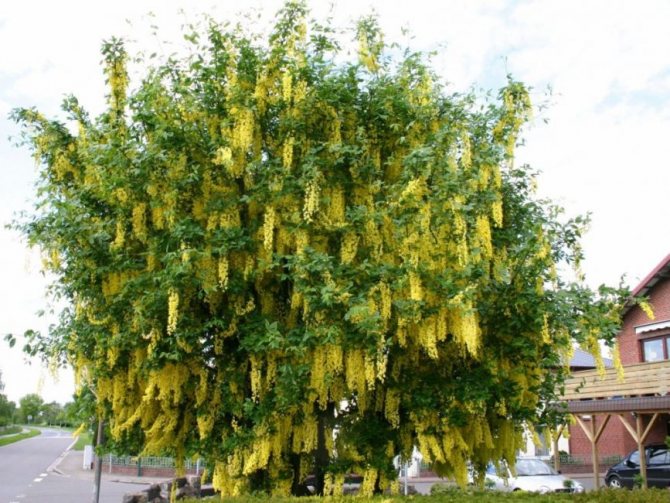

Bobovnik is well adapted to the urban environment
The legume grows best in rich, well-drained, loose soils with a lime content. This shrub is calcephilous. In other words, it refers to plants that grow best in soils rich in calcium compounds (limestone, chalk, and other sedimentary rocks).
Bobovnik does not tolerate soil compaction very well. The land for planting the plant must be of high quality, permeable, not prone to moisture accumulation and not acidic. Only on well-calcified soils are favorable conditions for the growth, development and flowering of the plant created. For this reason, you need to constantly monitor that the soil mixture on which the legume grows does not have high acidity.
back to menu ↑
See also: Barberry: description, types and varieties, planting in open ground, care, features for different climatic conditions including Siberia (65 Photos & Videos) + Reviews
Propagation by cuttings
Another breeding method is with herbaceous cuttings, which are cut in June. The Vaterer hybrid is propagated by woody cuttings collected in March. The length of the planting material is 15-20 cm. The lower leaves must be removed. Before planting in a peat-sand mixture, the cut of the cutting is dipped in powder for root formation.


After planting, the soil is evenly watered and the pot is covered with a transparent bag. Rooting time is approximately 5-6 weeks, provided the soil is constantly moist. A month after rooting, the plants are transplanted into open ground and insulated for the first 3 years in winter with fallen leaves or spruce branches.
Bean diseases
When the weather is warm and humid, the bean plant is always in danger of being affected by powdery mildew. The leaves of the affected plants are covered with a powdery gray bloom on both sides. If the plant is severely affected, then I can recommend using biological fungicides.
Self-seeding is often formed around the tree. Bushes that have grown from seeds begin to bloom at 5-6 years. In central Russia and even in Ukraine, in some winters, the branches of the garden bean freeze slightly.
The plant has a bright, poisonous color for a reason. The fact is that the garden bean is poisonous.
All parts of it are poisonous: foliage, branches and especially seeds, therefore, when planting and pruning, you must be careful and wash your hands after finishing work.
I would like to emphasize once again that bean seeds ripening at the end of summer are especially dangerous, therefore, if you are afraid for the health of your children, then you will have to give up the beauty of bean.
Reproduction by layering
The method works if the bush produces side shoots. They are cut closer to the base, laid in a prepared trench 1-2 cm deep with a cut down, fixed to the ground and sprinkled with fertile soil. The next year, if the layer has all the signs of growth, it is separated and transplanted to a new place.
Legume plant in landscape design
The tree looks great as a tapeworm against the background of a lawn or in a composition of low conifers and decorative deciduous and flowering shrubs: spirea, barberry, azalea, buddlea, etc. Due to drooping flexible shoots, the culture is widely used for landscaping pergolas, arbors and trellises.
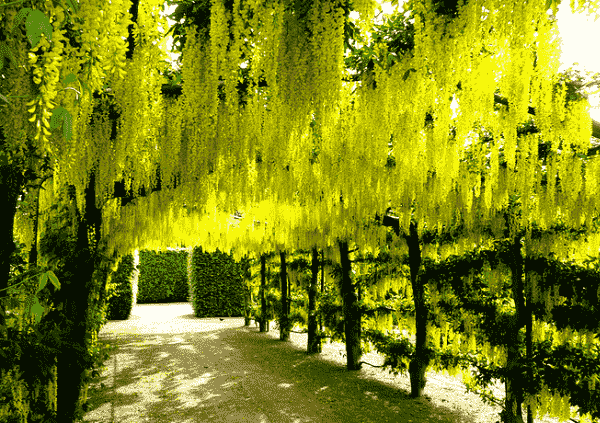

The most popular type of garden landscaping is the creation of arches, awnings and tunnels. The horizontal arrangement of the shoots in the upper part of the tunnel stimulates them to bloom especially abundantly, and planting a garden bean in a composition with wisteria creates an indescribable effect.
Overhanging green shoots of plantings in summer are a contrasting background for bright roses, phlox, lavender and hydrangea, etc.
Diseases and pests
The ornamental bean shrub in care is quite resistant to diseases, however, in unfavorable growing conditions (high humidity, excess water in the soil), the culture can be affected by fungal diseases, which appear in the form of round spots on the leaves. At first, the spots are gray and then turn brown.
At the first signs of disease, the plantings are treated with antifungal drugs, for example, Topsin M 500 SC. Sick fallen leaves in the fall must be burned.
If in spring, in wet weather, new tree sprouts and inflorescences turn brown and begin to die off, then this indicates a lesion with gray mold. All parts of the plant affected by the disease are removed and the Signum 33 WG plant is treated. The treatment is repeated after 10 days.
Most common pests: spider mites, which cause mosaic discoloration of leaves and aphids.
Attention! Be careful when caring for legumes, as all parts of the plant, especially the seeds, contain the toxic alkaloid cytosine and other quinolizidine alkaloids that can cause poisoning if ingested.
A lethal dose for an adult is several dozen seeds, for dogs and cats it is much less. Symptoms of poisoning appear after 15-60 minutes in the form of burning sensation in the mouth, throat, cramps, nausea and vomiting.
| Anagirid bean | |
| Scientific classification |
| Domain: | Eukaryotes |
| Kingdom: | Plants |
| Subkingdom: | Green plants |
| The Department: | Flowering |
| Class: | Dicotyledons [1] |
| Superorder: | Rosanae |
| Order: | Leguminous |
| Family: | Legumes |
| Subfamily: | Moth |
| Tribe: | Jerky |
| View: | Anagirid bean |
Bobovnik inspired JRR Tolkien to create Laurelin, one of the two mythical trees in The Silmarillion, and his description is exactly the same as in Thompson's poem [16].
One of the most popular and beautiful deciduous trees is the legume garden shrub, which is known for its yellow flowers and can be seen in May - June. Its color is similar to golden flowing brushes. It was this feature that gave it its second name "golden rain".
This type of plant belongs to the legume family.
Its temperature tolerance is up to -25 ° C. Therefore, the legume garden shrub will take root in areas with not very cold winters.
The plant does not like cold winds and drafts, but it must be planted in an open place where there will be enough sun for its development.
After a month of flowering, beans appear on the tree. In no case should these fruits be eaten, since they are inherently poisonous.
It should be noted that the leaves of the tree, flowers and other parts contain the alkaloid cytisine, which is dangerous to humans.
There are several types of shrubs - anagirolistny, alpine and Werterer hybrid. Each of them has its own characteristics of planting, growing from seeds and care.
Below you will familiarize yourself with these characteristics, as well as view a photo of three types of bean.
Healing properties
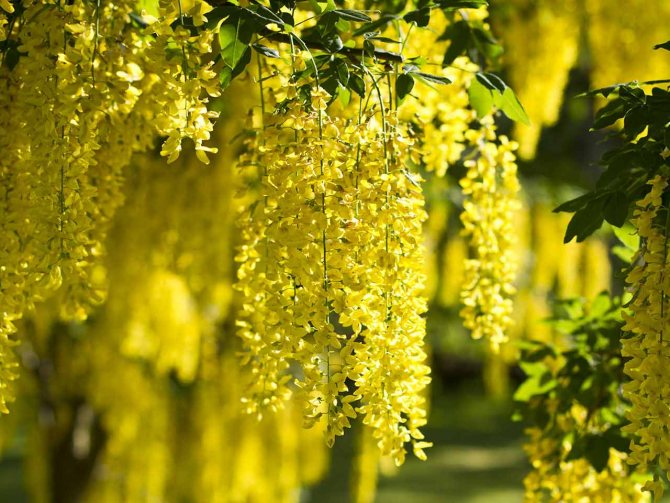

However, as often happens, poisonous plants also have medicinal properties. In medicine, young shoots and seeds are used. Amino acids, sulfur, copper, phosphorus, pectin and many other substances are contained in legumes. In official medicine, plant extract is used for headaches, low blood pressure, eye diseases. To avoid health problems, be sure to coordinate your actions with your doctor.
One of the most popular and beautiful deciduous trees is the legume garden shrub, which is known for its yellow flowers and can be seen in May - June. Its color is similar to golden flowing brushes. It was this feature that gave it its second name "golden rain".
This type of plant belongs to the legume family.
Its temperature tolerance is up to -25 ° C. Therefore, the legume garden shrub will take root in areas with not very cold winters.
The plant does not like cold winds and drafts, but it must be planted in an open place where there will be enough sun for its development.
After a month of flowering, beans appear on the tree. In no case should these fruits be eaten, since they are inherently poisonous.
It should be noted that the leaves of the tree, flowers and other parts contain the alkaloid cytisine, which is dangerous to humans.
There are several types of shrubs - anagirolistny, alpine and Werterer hybrid. Each of them has its own characteristics of planting, growing from seeds and care.
Below you will familiarize yourself with these characteristics, as well as view a photo of three types of bean.
Breeding process and growing bean from seed
You can get such a tree not only by buying seedlings, but also growing a legume from seeds at home. In turn, when buying seedlings and replanting them, you should know where the tree was brought from.
So, for example, when purchasing a seedling from Holland - be careful, because the probability that it will freeze up above the snow cover is very high. Therefore, pay attention to products brought from Poland or the Czech Republic. They are more hardy during the cold season.
Growing leguminous plants from seeds is a multiplication process that requires patience from the grower as the onset of flowering is delayed.
Growing a tree using seeds is easy if you know a few rules to help it grow normally.
It is advisable to sow them before winter. This will avoid a number of processes. If, it turns out to sow only in the warm season, then you should first put the seeds in the refrigerator for 1-2 months, and in the spring pour hot water over them.
In order for the seeds to germinate faster, they must be subjected to the scarification process, which means a little damage. This is done with a nail file or you need to shake the seeds in a sandpaper bag. Sow them in open ground under glass or cover with a bag.
Over the summer, you will grow a half-meter tree (possibly smaller). You will see flowering only after 5 years.
How to propagate leguminous plants
There are several ways to breed broom:
- With the help of seeds;
- Cuttings;
- Layers;
- Graft;
- Division of the bush;
The most common and easy breeding method is planting seeds... This can happen involuntarily: the bean plant throws out its seeds around itself, from which new plants develop. They can be dug up and transplanted to a new location.
The seeds themselves must be rubbed with sandpaper and sown into prepared furrows to a depth of 1 centimeter, and then sprinkled with earth. In three years the bean plants will bloom.
Propagated by layering. To do this, the plant branch is bent to the ground, fixed and covered with earth. After a year, it will turn into a full-fledged tree that can be transplanted. Bush division is also practiced by gardeners.
Hybrid bean usually propagated by cuttings and graftingso that their decorative qualities are preserved.
Bobovnik anagirolistny: care and features, photo
Delightful and vibrant anagiroli bean grows up to 7 m in height. Another well-known name for it is broom.
A distinctive feature of this species is its large inflorescences from 30 to 50 cm, which makes the plant look like a golden shower.
There are certain features of caring for this species, they are described below.
Before sowing, seeds should be germinated in a greenhouse, and the resulting seedlings should be transplanted into a pot. After the plant reaches 55 cm, it can be planted in the ground in a permanent place.
It should be noted that this tree is very thermophilic and will freeze even at temperatures below -26 ° C. Moreover, in spite of the fact that in other countries the shrub can grow quietly in the shade, bean plants in the Moscow region should be planted in places where there is a lot of sun.
Please note that if the planting material is taken from a tree that grows and hibernates in your area, then such a seedling will be immune to cold.
Nevertheless, some time should be given to the plant enough attention for normal adaptation. More frost-hardy and hardy trees are those grown from seeds.
Look at the photo of the anagyrolist bean, for which timely and proper care is carried out:
Soil for broom should be rich in calcium. If your case is acidic soil, then you have no reason to worry. After all, this is a normal environment for the growth and development of shrubs.
As for watering, there are no specific features here either. Leguminous plants require water only during drought periods.
To grow the root system, cover the soil near the legume with organic materials. This is especially true for the first few years, when the plant develops resistance to cold weather and other climatic features.
Also, don't forget about compost, which will serve as additional protection.
Main types
The broom is represented by only three types:
- Alpine... The tallest variety, which in natural conditions can grow up to 12 m in height. The size also affects racemose flowering shoots, drooping down 45 cm. One of the main characteristics is increased frost resistance. Despite the fact that during cold winters, the upper branches can be affected by low temperatures, the lower part and roots almost never freeze out.
- Anagirolytic... In nature, it grows at the foot of the mountains and in rocky ground conditions. It is quite cold-resistant and not very demanding to care for. The height of this variety is less (up to 6 m), and the brushes are shorter, but when flowering it exudes a stronger aroma. Decorativeness during flowering lasts about a month.
- Vaterera (hybrid). Combined the advantages of the two previous varieties, therefore it has a delicate aroma during flowering, which occurs twice a season. The only drawback is vulnerability to cold temperatures, so it is not recommended to grow Vaterer bean in the middle lane.


Agrotechnical care for these three species is not at all different.
Alpine Bobovnik: photo, features and characteristics
More resistant to frost is the alpine bean with its characteristic differences.
Its main feature is light green foliage, small flowers that do not have a scent. Also, you will not see naked beans on it.
Another characteristic is that flowering occurs somewhat later. Plant height reaches 10 m in its usual environment. Although in our area the tree reaches a maximum mark of 3 m.
Despite its hardiness, growing the plant is just as difficult. Therefore, it is necessary to create optimal conditions for its development.
The process of growing Alpine legume must be in accordance with the rules and regulations. It includes 3 stages:
· Germination of seeds in the greenhouse;
· Sprouts are transplanted into a pot;
· Seedlings 50-55 cm are planted in open ground.
It should also be remembered that this plant does not like cold winds, prefers soil with slightly acidic cultivated loam or rich in calcium.
Look at the photo of the alpine bean in the stage of its flowering and fruiting:
Diseases and pests
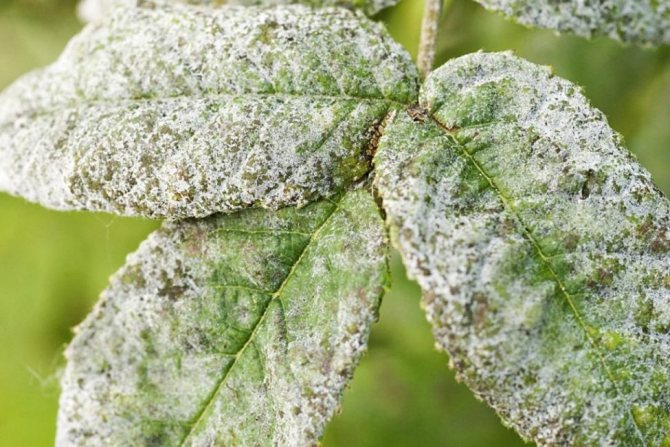

Powdery mildew or leaves
The fact that the legume is poisonous is beneficial to this plant, since it is practically not damaged by pests. The only trouble that can happen to this shrub is powdery mildew.
It can happen if the weather is humid and warm for a long time. For treatment, it is necessary to treat not only the leaves of the plant with a systemic fungicide, but also the soil, in the dosage indicated by the manufacturer.
back to menu ↑
See also: Perennial flowers (33 main species): garden catalog for a summer residence with photos and names | Video + Reviews
Unique hybrid - Vaterer bean (with photo)
If you want something unique for your garden, then the Vaterera bean is the best deal. It is thanks to the synthesis of the alpine and anagirolist species that we have the opportunity to enjoy the beauty and aroma of the "golden rain".
This unique hybrid has absorbed all the best qualities of its relatives. The result is a plant with the following characteristics:
· Grows up to 1 m;
· Long leaves are dark green in color (up to 50 cm);
· Inflorescences are silky and lowered;
· Has a delicate aroma.
The only drawback of the hybrid is the low level of frost resistance. That is why it is often exposed to freezing and the plant does not bloom as efficiently. Therefore, it should only be planted in a warm area.
Vaterer's Golden Rain bean propagates by cuttings. D
the photo below shows the most beautiful and strong specimens of the plant:
Seat selection
The plant loves sunny and semi-shaded places, so it is planted in a sunny place, protected from the cold north wind, for example, from the south side of the house or other buildings on the site.
It is important to consider that from a lack of sunlight in a garden bean, leaves may crumble or flowering may be weak.
By the way, for central Russia, planting a bean tree would be optimal not alone, but in a group with other garden trees and shrubs. With this planting, golden rain tolerates winter better and gives more intense flowering.
Crop care and bean disease
As we have already understood, the caring for the legume must be done competently, taking into account all its features. It is carried out in three stages - watering, feeding and pruning.
Top dressing should be done 2 times a year - in the spring with nitrogen fertilizer, and in the fall, use products containing phosphorus and potassium.
In order not to burn the root system, it is always necessary to use only non-concentrated organic fertilizers.
Recall that the root system of the plant is on the surface, which gives reason to be even more careful. It is also important to weed and remove weeds while caring for your crop for normal growth.
Do not forget that the plant should be rid of dry leaves and branches. When pruning, it is important not to trim the dry shoot back to living tissue.
By the way, in order for the bean plant to bloom next year and delight you with its aroma, you should cut off the fruits in advance so that they do not fully ripen.
As we said, the whole plant is poisonous. Therefore, bean pests and diseases are rare.
However, if the shrub is kept for a long time in humid and warm weather, then negative consequences should be expected. The disease manifests itself on the leaves on both sides in the form of a gray coating.
In this case, care for the plant should be done with biological fungicides.
Care
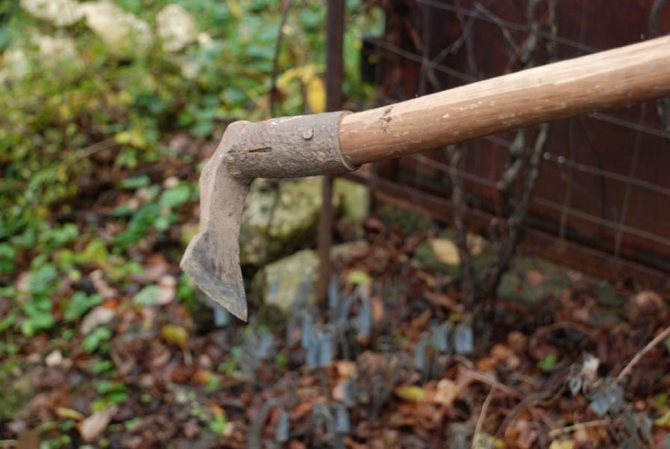

When loosening the soil of the trunk circle, you need to be especially careful
In addition to choosing the right place for planting the legume and providing the plant with a suitable soil for it, there are several more conditions that must be observed in order for the shrub to please you with a "golden shower" of its flowers:
1 Watering... Bobovnik has enough moisture, which it receives in the form of precipitation. The shrub tolerates dry periods well and should only be watered during particularly dry months.
2 Food... Bean should be fed twice a year. In the spring, nitrogen fertilizers are best suited for this, which are necessary for better growth and development. In the fall, phosphorus-potassium fertilizers should be applied, which are needed for better wintering of the shrub. Organic fertilizers for dressing bean plants must be diluted so as not to burn the root system, which is shallow. Top dressing is made starting from the second year of growth.
3 Mulching... The bean tree can withstand relatively dry periods without too many problems, but the trunk circle must be mulched. Compost is suitable for this purpose. It performs several functions at once:
- retains moisture in the soil
- saturates the soil with nutrients
- promotes good root growth.
When loosening the trunk circle, weeding and removing weeds, it must be remembered that the root system of the bean plant is close to the soil surface. All work should be done carefully so as not to touch or damage the roots of the plant.
back to menu ↑
See also: Dogwood: description, planting in the open field, care, reproduction, possible diseases - a plant for all occasions (50+ Photos & Videos) + Reviews
Pruning and shaping the crown
When it comes to shaping pruning, the shrub practically does not need this operation. The plant has a beautiful crown that forms naturally. Over-pruning can harm the legume. However, if the shoots are damaged or freezing, it becomes necessary to carry out sanitary pruning.


Bobovnik practically does not need shaping pruning
During this operation, carefully cut out all diseased and damaged shoots, as well as old, weak, thickening the crown and interfering branches.
When sanitary pruning, you must follow the rules:
- pruning should be carried out in the spring, before sap flow begins
- no need to remove the dead shoot to live wood, so as not to injure the plant
- small pruning of young bushes enhances their branching and stimulates flowering
- adult plants tolerate pruning very hard, so it is done in exceptional cases
- the formation of the crown of young plants should be completed before the seedlings are three years old and they reach a height of 1.5 meters
The removal of large branches on mature plants should not be carried out, as this can lead to the formation of hollows. Rejuvenating old specimens also does not lead to positive results. In this case, it is recommended to replace old plants with young seedlings.
back to menu ↑
See also: Gerberas: how to grow a tropical flower at home. Description, varieties, care, reproduction, possible diseases (50+ Photos & Videos) + Reviews
Winter care
Young plants need shelter for the winter at least in the first 2-3 years of life. To do this, use a covering material folded in several layers. As additional protection, sprinkling of the root system with compost is used.
Adult bean shrubs do not need shelter, but during the winter months it is necessary to shake off the snow from their branches so that they do not break under its weight.
back to menu ↑
See also: Potatoes: a description of the 73 best varieties + Reviews of gardeners
Garden decoration and other uses
Despite the complexity of growing from a plant, you can create unusual arches or harmonious compositions with flowers and trees. The bright yellow color of a flowering tree will be perfectly diluted in gardens, parks with plants such as juniper, spruce or thuja.
When decorating a garden, a harmonious ensemble is reproduced with flowers of blue or lilac shades.
There are other ways to use the legume garden shrub. Very often, designers use wisteria, colquitia, hawthorn, mock orange, exotic scumpia and rhododendrons for compositions with legumes. You can also create your own landscape with your favorite colors.
Recall that the plant is unpretentious and will tolerate any neighbor next to it. Planting a bean plant is also great for both large and small gardens.
The wood of the plant is also valued as a material for making wooden sculptures and musical instruments.
Also, the legume composition has special substances (cytisine), which are used for medicinal purposes - from smoking or in homeopathy. Therefore, the plant is versatile in use.
Hello everyone, my name is Natasha! I love plants and decor. I make florariums, collect a collection of plants, maintain a pharmacy "vegetable garden", and also maintain a blog lovgarden for everyone who is passionate about the theme of the garden, vegetable garden and plants as much as I am.
| International scientific name | |
| Anagirovid bean , or 1] of the legume family ( Fabaceae ). The plant got its specific name due to the similarity of its trifoliate leaves with the leaves of plants from the genus |
Bobovnik.
Bobovnik
The drooping flowers are bright yellow in color, appear in the garden from May to June. Bobovnik, or golden shower, is one of the popular garden plants. Unfortunately, the beautiful unpretentious shrubs and small trees that form the genus group blooming in early summer are poisonous. Leaves, branches and especially bean seeds are poisonous. It's a pity, damn it, but if you follow the precautions, it seems like you can survive.
Common bean - reaches 5-7 meters in height. Side branches branch off from the main shoot of the shrub at an acute angle, and thin young shoots droop downward in an arc-like manner. Numerous sulfur-yellow flowers are collected with intergrown sepals collected in racemose inflorescences up to 20 cm long.
Bobovnik Vaterer - was obtained by crossing the common bean with the Alpine bean. This plant has not become widespread, but experts also recommend it for garden cultivation. This species reaches a height of 4-5 meters, their branches are covered with dense glossy foliage, however, unusually bright, yellow inflorescences reach twice as long - up to 50 cm.
The tall and slender bean is a suitable plant for a small garden. As an ornamental specimen, the bean plant can be grown, for example, near the terrace, in the front garden and on the lawn, where it is not obscured by other trees. The bean plant looks especially beautiful in isolated groups of 2-3 plants, as well as in flowering hedges.An extremely unpretentious bean plant feels good even on stony-sandy, infertile soil. Unfortunately, all parts of the plant are POISONOUS, I have already spoken about this. Of particular concern are seeds that begin to ripen in August in brown beans. Therefore, if you have small children, it is better to refuse growing legumes.
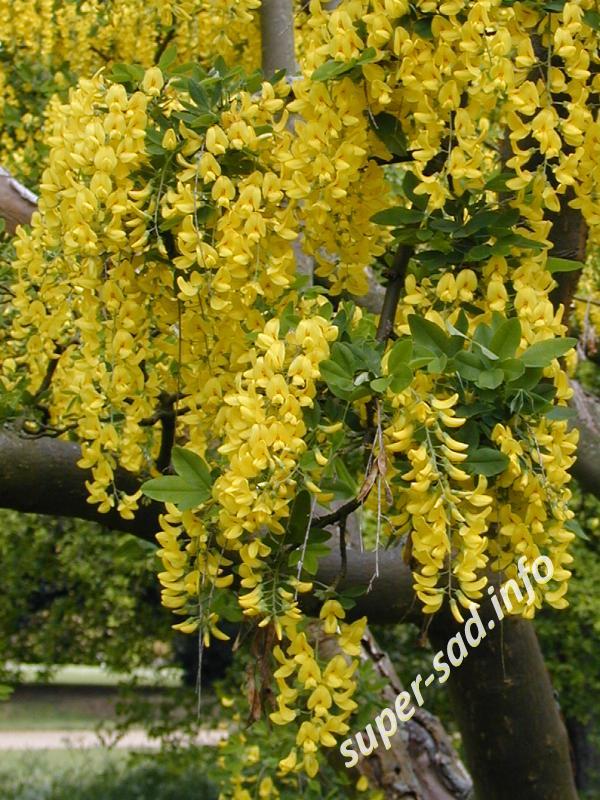

Undemanding to growing conditions, the legume is a versatile plant, an ideal partner for various shrubs and flowers. Legume is a traditional component of flowering hedges, a bright yellow spot against the general background. Bobovnik goes well with other shrubs that bloom at the same time as wisteria, colquicia pleasant, common hawthorn and mockweed. A wonderful neighbor is an exotic ordinary scumpia. Rhododendrons are often grown next to the bean. The golden-flowered beanberry looks great against the background of dark conifers and shrubs. The original solution is a legume in a heather flower bed. Under it is a carpet of heather, carnation - grass or decorative grasses.
It is better to buy young strong bean bushes with an earthen clod or in a container from September or before the leaves begin to bloom in May. You do not need to buy plants that are too large, on which leaves have blossomed, as they do not take root well. You will have to find a place that is sunny or semi-shady. Bobovnik prefers well-lit areas, but grows well in slightly shaded areas. The soil should be permeable, not prone to moisture accumulation. The bean plant grows even in poor and calcareous soil. The common bean is propagated by seeds. In the fall, sow pre-harvested mature seeds in moist seedling soil. The legume does not need to be pruned regularly. This shrub does not tolerate radical pruning. Powdery mildew is common in warm and humid weather. The leaves of diseased plants on both sides are covered with a gray powdery bloom. In case of severe damage, I recommend using biological fungicides.
To plant in a pre-selected place, we dig a hole, the volume of which should be twice the volume of the seedling's earthen clod. Mix the soil with compost. We take the plant out of the pot and straighten the roots a little. A seedling with a dry earthen clod should be watered before planting. We drive a support pole into the planting hole, then we place the seedling into the depth of the earthen clod. We fill the hole with enriched soil and tamp the surface, form a watering circle. Water the plant abundantly. We tie the bean trunk to the pole with a figure-eight loop. We mulch the soil in the near-stem area of the plant with compost. The common bean plant reproduces very well by seeds and cuttings. Hybrid varieties propagate only by cuttings.
I am amazed at the beauty of this shrub, and to hell with it that it is poisonous, the main thing is to protect yourself in time. Good luck to you.
Botanical description [edit | edit code]
Shrub or small, unbranched deciduous tree 4-9 m high and 3-4 m wide crown. The bark of the trunk is grayish-green or light brown, furrowed-wrinkled, young branches are dark green, pubescent, drooping. The foliage is alternate. Leaves are petiolate, entire, with a wedge-shaped base, glabrous above, below at the beginning of the growing season velvety, silvery pubescent, in summer - bluish-green, compound, trifoliate, 3-7 cm long, one leaf 3-8 cm long and 2.5 cm wide , elliptical-lanceolate or obovate [5] [6] [2].
Flowers are bisexual, moth type, bilaterally symmetrical, yellow, with 5 petals and a double-lipped calyx 5 mm long, on silvery pubescent pedicels, collected in drooping racemes 15-25 cm long [7] [8]. Flowering from May to June in places of natural growth [9].
The fruit is a pod, flattened, green, pubescent, with a pointed tip 4-7.5 cm long and 7.5 mm wide, contains 2-7 dark brown seeds [10] [5]. Fruit ripening from September to October [9].
Life expectancy is about 20 years [11].
From another species of the genus Bobovnik (Laburnum), Alpine bean [en] (Laburnum alpinum
), is distinguished by shorter inflorescences and a denser packing of flowers in them [10].
Layers
Young shoots are pressed against in early spring. To form roots, before digging in a branch, it is necessary to cut off the bark or make cuts on it. The use of growth stimulants will speed up the root formation process. Vertical shoots will appear on the rooted branch next spring. The daughter plant is separated from the mother plant in a place with soil, taking care not to damage the roots.
(Laburnum), Golden Rain
,
broom
- these are all names of one plant of the legume family. It can be a tree or a multi-stemmed bush 2-6 m high. Bobovnik is a fairly winter-hardy plant; it begins to bloom with golden brushes in late May - June. Flowering lasts up to 20 days. After flowering, beans with seeds are formed, which are poisonous, like all parts of the plant. They contain alkaloids: cytisine and laburnine, which are dangerous to humans. Who has children. it is better not to plant legumes: if a child eats a couple of seeds, he may die.
Anagirolist bean
(Laburnum anagyroides) has inflorescences up to 50 cm long, which really look like a golden shower. And a tree or a bush blazes with gold brighter than. Now there are varieties with pink flowers and yellow young leaves.
Location, soil
In order for the bean plant to please with abundant flowering, it must be planted in an open, sunny place, protected from cold winds and drafts. In the shade, the plant practically does not bloom, and the foliage can turn yellow and fall off.
The leguminous soil prefers loamy soil, which retains moisture well, not acidic, but always loose. However, it can grow well on sandy loam, rocky. But the legume grows in the Moscow region slowly: in 10 years it can reach only 3 m.


Landing
The best time to plant legumes is in spring. Dig a planting hole slightly larger than the root ball of the seedling. Recommended soil composition for planting leguminous plants: 15-20 cm of the top garden soil removed from the pit, peat, compost (humus), sand in a ratio of 2: 1: 2: 2. To this mixture add 300-400 g of dolomite (limestone) flour and 40-70 g of any complex granular fertilizer. Mix everything well. The seedling is planted, the soil is compacted, watered, etc.
Plants must be soaked before planting in a solution of any growth stimulant (, epin, humate, etc.) or an infusion of natural stimulants. If a seedling with an open root system, then leave it in the solution for 12-18 hours, and if the plant is bought in a container, then for 30-40 minutes.
Care
The bean tree must be cut by removing dry, broken branches, as well as forming an appearance, then the bush (tree) will look neat and compact. In order for the plant to bloom annually, it is important to remove the beans, preventing the plant from spending energy on ripening them if the seeds are not needed.
They feed in early spring and September. Nitrogen is needed for spring feeding. It is better to use liquid for this - they are absorbed faster and do not burn the roots, because the root system of the bean plant is close to the soil surface.
Shelter for the winter
How to shelter a legume for the winter and is it necessary to shelter? The answer to this question depends on where the seedling growing in the garden came from. If a seedling is from Holland, then it is not long-lived, it will always freeze above the snow cover, and then it will fall out completely. Saplings from the Czech Republic and Poland are more stable in the Moscow region. The first 2-3 years, while the seedling is small, for the winter it is recommended to wrap it with lutrasil and tie it with twine. Then its winter hardiness will be higher, only the ends of unripe shoots will freeze.
If the plant is grown in a local nursery, then it is not even necessary to cover it. This seedling is adapted to local conditions and will also winter well.
Reproduction
How can bean plants be propagated? It's very simple: seeds, green cuttings, dividing a bush, layering.
Seeds
... It is quite simple to grow a legume from seeds and such plants will be more winter-hardy, more adapted to local conditions. Fresh seeds can be sown before winter. And if you sow them in indoor conditions in the spring, then the seeds must go through (stratification, scarification), and then they are planted in prepared light soil. The containers with the planted seeds are covered with glass or foil. With good care, seedlings grow up to 40-50 cm over the summer. Such plants bloom only for 5-7 years. And there is a high probability that it will not be possible to obtain a varietal plant from seeds.
Green cuttings
... With this reproduction, all varietal characteristics are preserved. Green cuttings with 2-3 internodes are cut immediately after flowering. The lower leaves are removed, and the upper leaves need to be cut by 2/3. The lower oblique cut can be treated with any root growth stimulant. Cuttings are planted in light soil in a shaded area. From above, it is recommended to close them with a half of a plastic bottle, which is removed when young leaves appear in the axils of old leaves. In the first winter, cuttings are covered with fallen leaves, cut perennials, spruce branches or non-woven covering material (lutrasil, spunbond).
By dividing the bush
... Divide the legume bush in early spring, before bud break. Dig up the whole plant and cut it into pieces with a sharp shovel or large knife. Do not forget to wear gloves when working, as all parts of the plant are poisonous.
Layers
... In the spring, a young shoot is chosen and pinned to the ground. In places of contact with the soil, the bark on the shoot is damaged and treated with root growth stimulants. By autumn, roots and vertical young shoots appear in these places. The next spring, the bent shoot is cut into pieces and planted.
Application in landscape design
Bobovnik is widely used in landscape design. Such a beautiful bush or tree looks best on a lawn in a solitary planting. Since his root system is superficial, ground cover plants can be planted in the legs of the bean grass: low, periwinkle, varietal tenacious or simply mulch the trunk circle with decorative chips.
In a group planting, the bean tree is stretched, it blooms poorly in shading. Therefore, lower plants are planted in the foreground: spireas, willow "nana", rhododendrons, dwarf or creeping conifers (spruce, globular thuja, etc.)
One of the most popular and beautiful deciduous trees is the legume garden shrub, which is known for its yellow flowers and can be seen in May - June. Its color is similar to golden flowing brushes. It was this feature that gave it its second name "golden rain".
This type of plant belongs to the legume family.
Its temperature tolerance is up to -25 ° C. Therefore, the legume garden shrub will take root in areas with not very cold winters.
The plant does not like cold winds and drafts, but it must be planted in an open place where there will be enough sun for its development.
After a month of flowering, beans appear on the tree. In no case should these fruits be eaten, since they are inherently poisonous.
It should be noted that the leaves of the tree, flowers and other parts contain the alkaloid cytisine, which is dangerous to humans.
There are several types of shrubs - anagiroli, alpine and Werterer hybrid. Each of them has its own characteristics of planting, growing from seeds and care.
Below you will familiarize yourself with these characteristics, as well as view a photo of three types of bean.
Distribution and ecology [edit | edit code]
In nature, anagiriform bean grows in the mountains of the Central, Southeastern and Iberian Peninsulas (in Austria, Czech Republic, Germany, Hungary, Switzerland, the former Yugoslavia, Italy, Romania, France). Grows best in temperate climates, but can also grow in the subtropics. Naturalized in New Zealand, also grown in Australia [11]. Calcephil, that is, it prefers calcareous soils [5].
Anagiriform bean forms mycorrhiza [12] and, like other legumes, enters into symbiosis with nitrogen-fixing bacteria. Pollination by insects (entomophilia) [8].
Features of vegetation
Bean is a fast growing plant. With the right choice of a site for planting and the creation of favorable conditions, the shrub grows quickly and enters the fruiting season quite early.
The legume begins to bloom and bear fruit at the age of three. The plant is quite thermophilic, but it can withstand temperatures down to -20-25 ° C.


In severe winters, the plant can freeze
Poisonousness [edit | edit code]
All parts of the plant contain the poisonous alkaloid cytisine, a derivative of the alkaloid quinolizidine. The content of cytisine in vegetative organs fluctuates seasonally: it is high at the beginning of the season and then decreases, but the content of this alkaloid in the vegetative organs of the plant is constantly high [13].
Anagirid bean is poisonous to humans. The main symptoms are due to a disorder of the central and sympathetic nervous systems. There are nausea, salivation, abdominal pain, increased sweating, convulsions, disorders of the heart and respiratory muscles [en] [14].
Precautions
All parts of the legume are poisonous because they contain the alkaloids laburnine and cytisine in high concentrations. The most poisonous seeds of the plant.
For this reason, the shrub is dangerous to humans. Plant poisoning entails a disorder of the central nervous system, impaired breathing, heart function, nausea, convulsions and other serious consequences for the body, up to a threat to life.
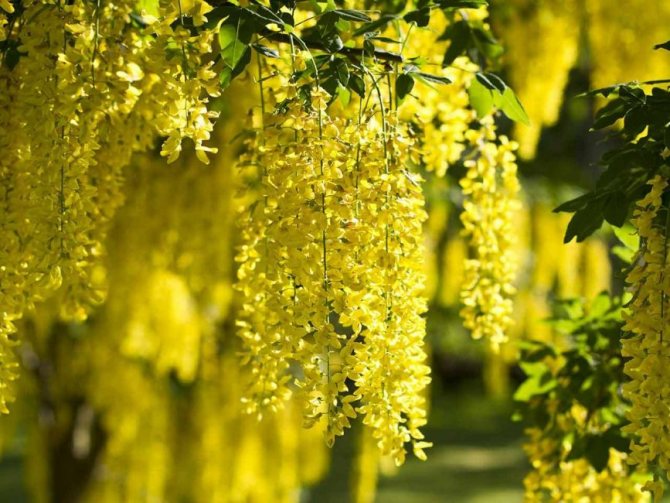

Behind the external beauty of the bean berry lies a danger - the plant is poisonous
Economic value and application [edit | edit code]
Leguminous wood is used to make tools and furniture. It is possible to use this plant as a rootstock for other legumes. Anagiriform bean is cultivated as an ornamental plant [14] (in culture since 1560 [5]). Its hybrid with alpine bean (Laburnum alpinum
) —
Laburnum × watereri
[5] .
- ‘Aureum’
- ‘Bullatum’
- ‘Carlieri’
- 'Chrysophyllum'
- ‘Incisum’
- 'Pendulum'
- ‘Quercifolium’
- ‘Serotinum’
- 'Sessilifolium'
- 'Variegatum'
The use of bean berries: where and how
In fact, the legume is a poisonous plant. Moreover, everything about the part is poisonous, especially the seeds. They contain a large number of dangerous alkaloids - laburnine and cytisine. Bobovnik belongs to one of the most poisonous plants in European flora, since even two accidentally eaten fruits can lead to a mortal threat to the life of a child.
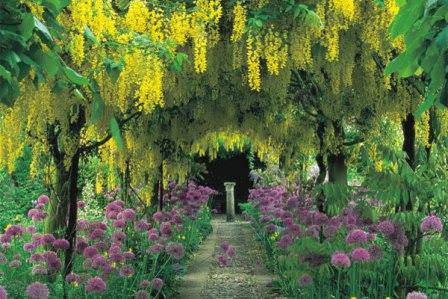

In this regard, when growing leguminous plants on plots, it is necessary to limit access to it for children and animals. But at the same time, the goat is very fond of the bean, it is not for nothing that it received the name Goat Clover. Also, the plant is an excellent honey plant.
In its structure, cytisine is very similar to nicotine. During the First World War, it was not tobacco that was even used for hand-rolled cigarettes, but this particular plant. It is currently used in smoking cessation and homeopathy.
Very beautiful, well-polished and hard beanwood is prized as a material for wooden sculptures, musical instruments, inlay. In ancient times, it was used to create crossbows, bows, which were in no way inferior to yew.
Bobovnik shelter for the winter
If the seedlings are purchased in a nursery, then they will not need additional shelter, since the young trees have already passed acclimatization. If they were grown independently, then it is better to protect them by covering them in the fall.
Since the young are very fragile, they should be bent to the ground carefully. After the branches are bent, the shrub must be covered with spruce branches and a thick layer of dry foliage. To prevent them from being blown away by the wind, they put lutrasil on top of the shelter and press it with stones.
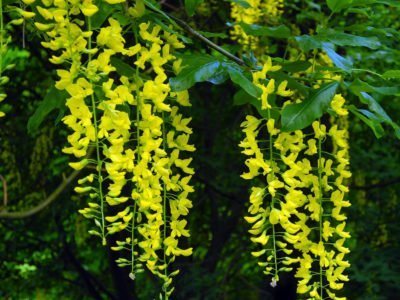

Varieties
There are several types of golden rain: anagiroli, alpine, Norwegian and hybrid. Anagirolist bean
is a tree up to 7 m tall, and sometimes even higher. This type of bean is the most popular. Inflorescences, as a rule, have a length of about 30 cm. There are about ten varieties of such a plant. There are plants:
- with weeping branches;
- with leaves blooming from the buds of a golden hue, which turn green by summer;
- shrub with loose branches and red bell-shaped flowers;
- with pink flowers on the brushes and light leaves;
- with leaves similar to oak in shape and color.
3. Varieties:
3.1 Anagyrolist bean or golden rain - Laburnum anagyroides
A very beautiful, sprawling tree originating from Central and Southeastern Europe. In its natural habitat, it reaches a height of 7 m. During the flowering period, it covers you with abundant and large clusters consisting of drooping clusters with white or yellow flowers and resembles wisteria. Leaves are green, compound, consist of three oblong-lanceolate leaves, each of which reaches a length of 7 cm. The lower surface of the leaf plates may have a slight silvery pubescence. All parts of the plant are poisonous.
↑ Up,


Bean Pruning
Formative pruning of a tree may not be carried out, since it itself is gaining decorativeness, over time its branches will take on a beautiful falling shape.
In the spring, you can remove some of the frozen branches, but this should be done in moderation so that the tree does not get sick. Pods with beans should be removed immediately after ripening to avoid self-seeding and improve the decorative qualities of the tree.
Since the branches of the tree have a sloping shape, in winter a large amount of snow sticks to them, and so that they do not break under its weight, they must be gently shaken off from time to time.


Growing features
Laburnum is very thermophilic. It tolerates temperatures not lower than -26 C, therefore, in severe frosts, the plant can freeze slightly. Young shoots are especially affected, but in severe frosts, old trunks often suffer. Therefore, plants in areas where frosts often occur should be sheltered from wind, snow and cold weather. Growing this beautiful plant does not require a lot of hassle, but in the middle climatic zone it is difficult due to the frequent frosts. Despite the unpretentiousness, gardeners prefer growing legumes from seeds and at the same time planting them in calcium-rich soils or in slightly acidic loam. Do not water it too often, but the earth needs to be loosened. You just need to remember that this perennial has roots close to the surface, so you need to be careful when loosening. The roots must be covered for the winter, preferably with an agro-canvas or a dense layer of peat, compost. In young plants, it is advisable to cover the stems, even where there are no severe frosts. To strengthen the roots, you need to mulch.
Soil for bean
For planting, you need to choose a nutritious soil with good drainage. It is best if the earth is alkaline. The acidic soil will need to be mixed with ash or lime in the fall so that planting can be done in the spring.
Laburnum does not like compacted soil and stagnant moisture, for this reason, the earth should allow air to pass through well, and a crust should not remain on the top layer of the soil after watering. Mulching the trunk circle will help to avoid this.
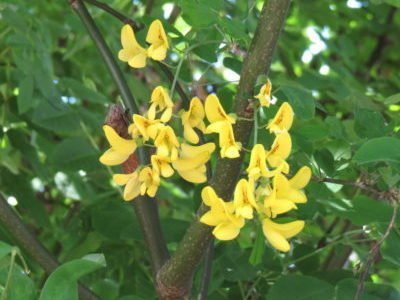

Bobovnik in garden design


Bobovnik in landscape design photo
Bobovnik will become a real "golden" decoration of your garden. Plant individual trees solo anywhere in the garden. The gazebo, located under the spreading crown, will become an even more comfortable resting place. Long liana-like shoots can be directed along the arch, other supports, creating a magical cascade, a corridor.
Bobovnik is suitable for being close to rhododendron, hawthorn, wisteria or scumpia.Juicy greens and bright inflorescences will stand out against the background of conifers in dark green or bluish tones.
Features of the
The main feature of the plant is that, with such beauty, it is absolutely unpretentious, but still it can be difficult to grow it. Bobovnik is an excellent honey plant. After flowering, it is advisable to cut off the branches of the inflorescences. Such actions improve the decorative appearance of the tree. It also blooms better the next spring after pruning like this. The legume is cultivated in the southern regions of the Crimea, Central Asia, the Caucasus, southern Ukraine and Europe, from where it came to us. In the north and in temperate latitudes, it grows rarely, develops hard, often freezes completely or partially. Therefore, in northern latitudes, it is usually grown in botanical gardens or greenhouses.
Reproduction
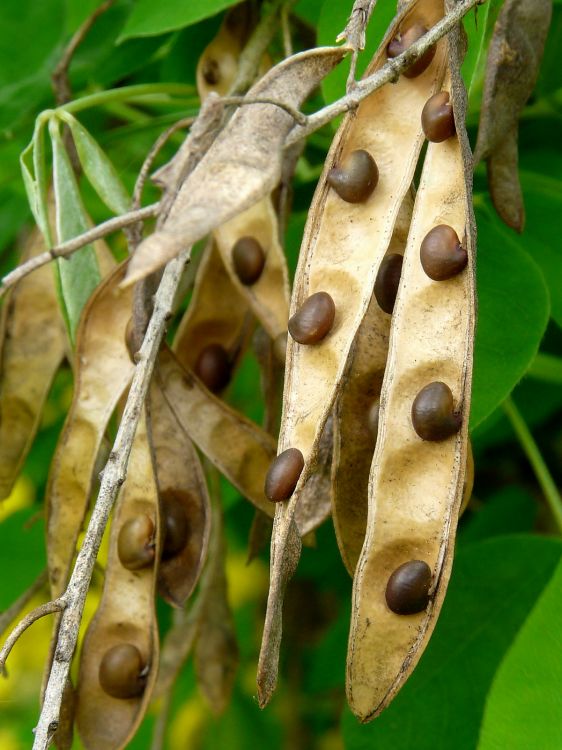

Many people admire the photo of the beanberry. Planting and caring for a plant involves breeding seedlings. Once the inflorescences have faded, bean-shaped fruits can be seen. They are located on an elongated leg and have a linear simplified shape. They have small wings on their sides. The fruit is about eight centimeters long, and the seeds are no more than three millimeters long. Gardeners advise against breeding this plant with seeds, as many of the positive qualities of the parent tree can be lost. The best option for them would be cuttings or propagation by layering. If you still want to use seeds, then you should do this:
- Immediately after collection, the planting material begins to be sown into the ground.
- The soil is fertilized with organic fertilizing and thoroughly loosened.
- The burial depth should not exceed one centimeter and be less than half a centimeter.
Usually, the seeds germinate very well, and after a while you can notice quite strong and friendly shoots. They are covered for the winter, and in the spring they are seated in permanent places. Typically, the first bloom can be seen four years after sowing.
Excellent results are obtained with cuttings. It is quite simple and easy to do. Cuttings are cut in advance in August. The length of each of them should be no more than twenty centimeters. They are planted in open ground, previously fertilized with top dressing. Next, the seedlings are watered and lightly covered from the weather. Until October, they do not require much maintenance other than regular watering. For the winter, they should be covered with foil.
You can also try the layering method. To do this, you need to choose one strong and long shoot growing at the bottom of the bush. A canal is dug and the shoot is fixed in it. After about thirty to forty days, the first shoots appear. Then they are separated from the shoot and transplanted to a permanent place.
Description of appearance
This small deciduous tree or shrub has trifoliate leaves, smooth above and slightly velvety below, and belongs to the legume family.
The plant sometimes grows up to 7 m in height. It has a funnel-shaped, loose crown and sometimes several trunks, somewhat reminiscent of a broom. The trunks are grayish-green or light brown in color, wrinkled in appearance. The perennial blooms in spring, when there is no longer any danger of frost. This is around May. Its bright yellow inflorescences, composed of moth-like flowers, sometimes reach 50 cm, and sometimes the bean-tree blooms for about a month. Long tassels resemble golden threads of rain. It is for this similarity that the bean (laburnum) got its name: "golden rain". When it blooms, everything looks festive in the yard, and the delicate scent of flowers adds romance to the garden. After flowering, graceful linear legume pods with fruits are formed. The Latin name laburnum means bob-trefoil.
Comments (5)
Emma
04.10.2017 at 00:07 |
A very beautiful plant, and the color is simply gorgeous, so sunny and warm.But leaving, it turns out, is not so simple, there are many difficulties and nuances of their own. But for the sake of such beauty, you can try.Reply
Julia Expert Plodogorod
27.10.2018 at 17:46 |
Hello Emma! Like any plant, the legume needs care and attention, but if you set up the process and follow the tips, it will look good and bloom profusely. Before watering, remove several layers of soil, even with your hands. When it is also dry under the top layer, then it's time to water your pet.
The shrub loves sunny areas, as well as warmth, consider this when choosing a site for planting. These plants love to grow in groups. So they can more easily endure the winter cold and bloom more abundantly. In winter, you need not only to cover the legume, but also to remove the snow from the branches, otherwise they will begin to break due to its weight.
Reply
Mockina of Light
29.01.2018 at 10:56 |
Bobovnik or "Golden Rain" grows on the site and we have no problems with it. Golden rain not only looks great from the outside, but also decorates perfectly. I believe that you also need to use Golden Rain in your family.
Reply
Anya
16.10.2018 at 00:15 |
A very beautiful plant, judging by the photo on this site, really looks like a "golden shower", you can even make an arch and the bush will braid it beautifully. Sometimes, instead of a biting grape variety, it is better to plant such a shrub.
Reply
Yana
20.10.2018 at 03:30 |
This plant was planted, it grows well and is not particularly demanding, although I cannot say that it does not need to be paid attention, attention must be paid, especially to a young plant.
Reply
Using
Basically, the legume is grown as an ornamental plant. It can often be seen in city parks. Prefers single or group plantings. With linear planting, the decorative effect of the plant is lost. Looks great together with conifers, kolkvitsiya, mock orange, scumpia, etc. It is a honey plant.
Souvenirs, sculptures, inlays and musical instruments are made from beanwood, which has a beautiful color, peculiar texture and durability. Previously, arches for bows and crossbows were made from the plant.
Cytisine, which is part of the bean, has a similar effect to nicotine. During the First World War, it was used for making hand-rolls. But smoking the leaves of this plant often leads to nausea and vomiting.
Now, broomsticks are used to prepare homeopathic remedies and remedies to help quit smoking.
Diseases
The most important feature is that golden rain is very poisonous. It is advisable not to plant this tree or bush in gardens to which children have free access. Two beans eaten by an unwary child is enough to cause death.
Use rubber gloves for gardening work involving contact with the plant.
Due to the extreme toxicity of all parts of the legume, it is not touched by all types of pests, it is almost not susceptible to disease. The only disease common to this species is powdery mildew. Not stopped in time, this disease leads to the complete loss of leaves. To protect against it, the leaves and branches of the tree are treated with fungicides.
All of the above rules are mandatory for gardeners who want to grow an ornamental and flowering plant on their personal plot - a bean. It is enough to carefully study them and adhere to them exactly so that planting and caring for this southern plant in the Moscow region will be crowned with success. Have a beautiful garden!
Diversity
There are 3 types of bean and many varieties.
In central and southern Europe, this tree can reach a height of up to 7 meters, but sometimes it remains low (up to 0.5 meters), and is often found in parks and gardens.
Usually broom leaves are trifoliate and are light green in color. Some varieties are characterized by golden or oak-like leaves.
Breeders have developed a decorative bean form, which they called "autumn". Its peculiarity is re-flowering in the fall.
Features of bean
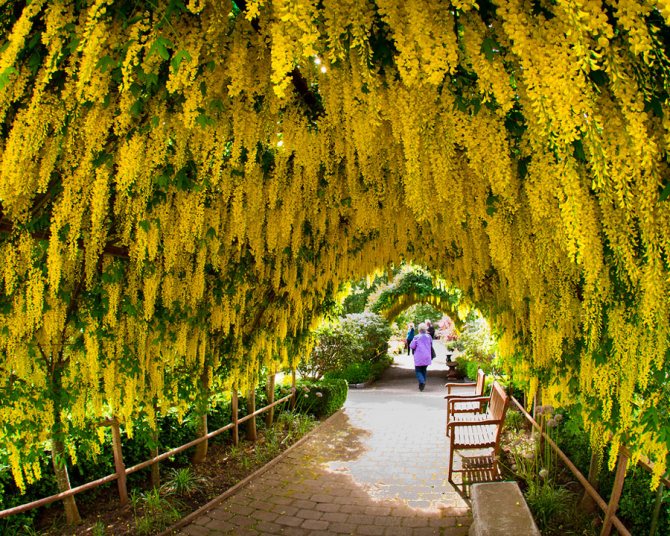

The height of the legume depends on what species and variety it belongs to, and can vary from 3 to 7 meters. Its crown is spreading with a diameter of 3 to 4 meters. It consists of flexible stems that can be straight or weeping. Before the plant blooms, trifoliate long-stemmed oval-shaped leaf plates grow on it. On the seamy surface of the foliage, as well as on the shoots, there is a slight pubescence.
Such a plant blooms in the last days of April, and fades in June. Small flowers of a rich yellow color have a shape similar to butterflies. They are part of lush brushes, which have a length of 0.2–0.5 m. A large number of inflorescences are formed on one bush. In place of withered flowers, fruits are formed, which are narrow and dry pods, reaching 50-60 mm in length. They fully ripen in September. When planting laburnum in a region with a cold climate, you need to take into account that in such conditions it will bloom more poorly and for a short time.
Flowering bean
Flowering time is in late spring - early summer and it lasts for a month. Legume inflorescences have the form of dense, large and long brushes, bright yellow, white, pink and lilac in color with a persistent pleasant aroma.
The shrub blooms profusely and attracts insects. In place of the faded inflorescences, small dark brown pods with beans are tied, which ripen by the beginning of autumn.
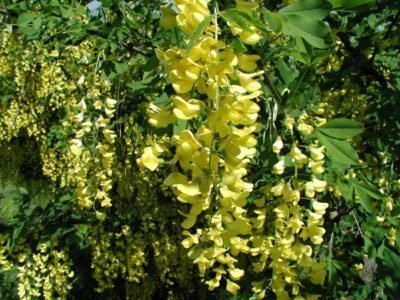

General information
The main difference between laburnum and other decorative tree-like cultures is the large inflorescences of yellow, pink, lilac and white, collected in hanging brushes. The length of the brush reaches up to 50 centimeters and, when blooming, exude a very pleasant aroma, similar to acacia.
If you take care of the culture correctly, it will delight the gardener with abundant flowering, the period of which will fall on the end of May and lasts until the end of June. When the legume fades in place of the inflorescences, fruits begin to set in the form of small pods with beans, thanks to which the tree can multiply by self-sowing.
It is quite simple to grow this amazing culture, the main thing is to take into account all the advice of experienced gardeners and an exotic bean tree will definitely appear on your site, which will delight with its lush flowering, filling the air with an extraordinary aroma.
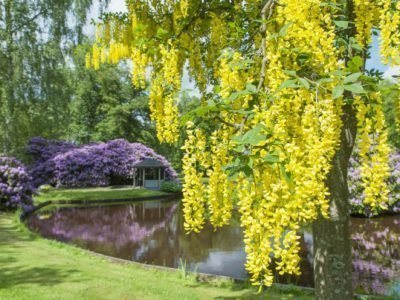

How to propagate leguminous plants vegetatively


Reproduction of bean cuttings photo
Vegetative breeding methods are the most successful. Varietal plants are recommended to be propagated vegetatively in order to preserve their unique differences. You can use the following methods:
- Cutting: in July-August, cut the young shoots, rooting in loose soil in partial shade. Cover the cuttings with a cap until roots form, water carefully. Such plants will need shelter for the winter in the first year of life.
- Vaccination: a varietal cutting should be grafted on a specific rootstock. Locate the vaccination site near the ground.
- Layers: bend the lower shoot to the ground and sprinkle with soil. In the place where the roots should appear, it is recommended to apply several cuts to the bark. After about a month, the roots will appear, the shoot can be cut and planted separately.
Winter care
This southern plant needs protection during frost. As a rule, starting from the end of October, it is covered from the cold. Frost-damaged shoots will not bloom well. In addition, heavy snowfall very often harms the branches of the bush. Therefore, in winter, you should monitor it and remove snow regularly. And also gardeners recommend to thoroughly insulate the bean tree itself. To do this, it is covered with a special material, and the lower part of the plant is added dropwise. In the spring, as a rule, pruning is carried out, in which dead plant parts are removed.
How to insulate a plant can be seen in the photo of a bean tree below. Leaving and planting the plant will not cause too much trouble for the gardener.


Bean transplant
Transplanting a shrub is undesirable, as it does not tolerate it very well. However, if it is required, it must be carried out very carefully so as not to damage the root system.
For this purpose, the legume should be dug up with the soil and transferred to a new planting hole, after adding compost to it, to ensure better rooting.
After transplanting, the tree must be watered and the trunk circle must be mulched. The transplant should be carried out in the fall, after leaf fall.
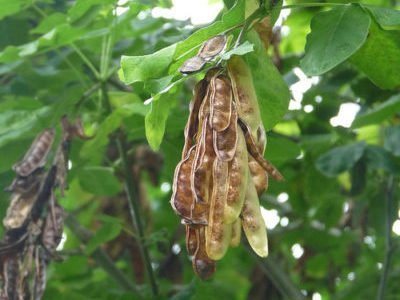

Planting a bean
When freezing, golden rain loses branches and shoots, the appearance of foliage deteriorates, and the number of flowering brushes decreases. Planting and care in the Moscow region should be maximally aimed at protecting the plant from frost.
In early spring, immediately after the snow melts, a hole is dug in a predetermined place, 1.5 times the size of the seedling clod. Pour it with water and after it is completely absorbed, a seedling and a support rail are placed in the pit. The pit is covered with a soil mixture consisting of excavated soil, peat, humus and sand in a ratio of 2: 1: 2: 2, carefully tamped and mulched with peat, moss or decorative bark. The seedling is tied to a pole.
It is ideal to plant the common bean in small groups so that the plants protect each other from the cold. It is important not to thicken the planting in order to provide trees or shrubs with access to light; in the shade, the quality of flowering decreases.

